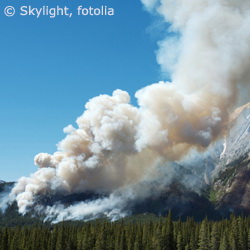Scientists spotlight wildfire regimes
Wildfires have a huge impact on terrestrial ecosystems across the globe. These fires are triggered by an interaction of weather, vegetation and land use, making them highly sensitive to change. Understanding the mechanisms that control wildfire regimes and improving the predictions of when and how they will change is important. Enter a German-US team of scientists that demonstrates how threshold values for wildfires exist. The research is an outcome of the PATRES ('Pattern resilience') project, which received EUR 1.2 million under the 'New and emerging science and technology' (NEST) Cross-cutting Activity of the EU's Sixth Framework Programme (FP6). Their findings are presented in the journal The American Naturalist. Scientists from the Helmholtz Centre for Environmental Research (UFZ) in Germany and the University of Michigan in the United States used a minimal model of fire dynamics that describes fire spread as a 'stochastic birth-death process'. This fire spread is similar to that of an epidemic spread. Using this model, the researchers replicated multiple regional patterns in fire regimes, enabling them to classify different regions in terms of their proximity to a critical threshold. They evaluated the time series for large fires from the Canadian Boreal Plains, which have moved from being a subcritical regime to a critical regime. The team suggests that large forest regions in Canada are on the cusp of rapid change. These areas may even surpass the threshold value due to climate change. The scientists say strategies for fighting wildfires in extensive parts of Canada must be reconsidered. 'Changes in the wildfire regime have a significant impact on a local and global scale and therefore on the climate as well,' explains Dr Volker Grimm of the UFZ. 'It is therefore important to understand how the mechanisms which shape these wildfires work in order to be able to make predictions on what will change in future.' The Canadian province of British Columbia sustained a significant loss in 2009 when some 1 000 hectares of forest and scrubland were burnt down. More than 10 000 people were forced to evacuate the area. Experts believe these types of events will only increase in number. Published literature presents similar theories as well, particularly how climate change could trigger a dramatic increase in the threat of wildfires in Yellowstone National Park in the United States. Some think that forests in the area may even disappear in this century. The team analysed data from the Canadian Forest Service which recorded fires spanning areas greater than 200 hectares between 1959 and 1999, and sorted these by ecozone. They identified that three of these Canadian ecozones are close to a turning point: the Boreal Shield, the Boreal Plains and the Hudson Plains south of the Hudson Bay. The Boreal Shield is the closest to a turning point, according to the researchers. The team assessed fires in these areas, finding that their average size trebled rapidly. 'In our opinion, this is a sign that there are also threshold values for forests above which the wildfire regime drastically changes,' says Dr Grimm. 'It is likely that the Boreal Plains have in recent decades, particularly around 1980, experienced a change to a system characterised by wildfires. This has fundamental repercussions for the environment and the combating of wildfires. Small changes in the fire propagation parameters have a great impact on the size of the fires.'For more information, please visit:Helmholtz Centre for Environmental Research (UFZ):http://www.ufz.de/index.php?en=11382The American Naturalist:http://www.jstor.org/stable/10.1086/663259
Countries
Germany, United States



